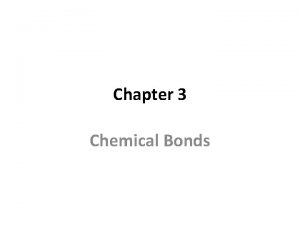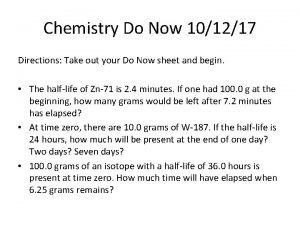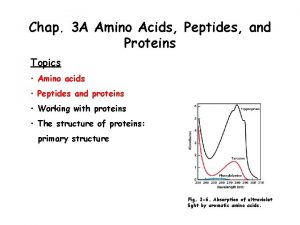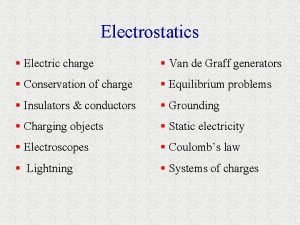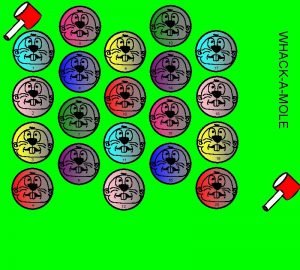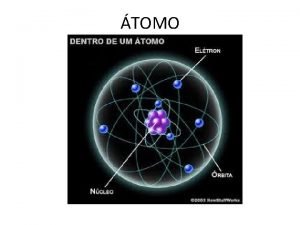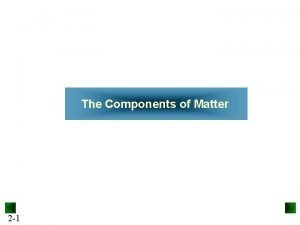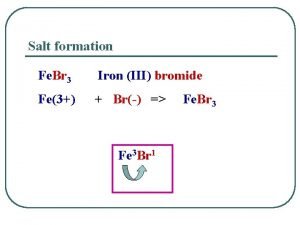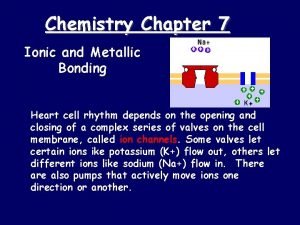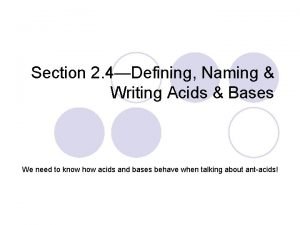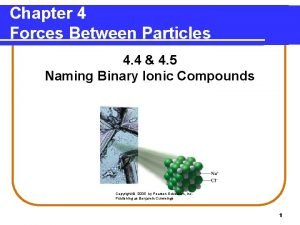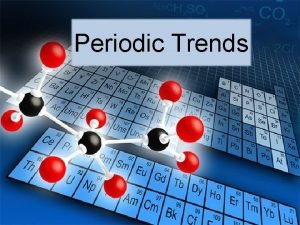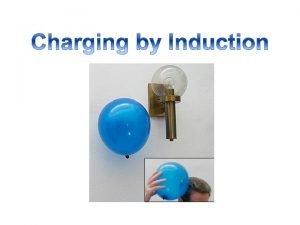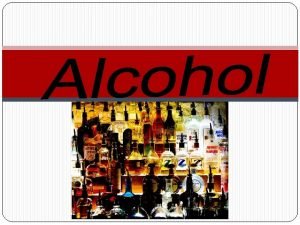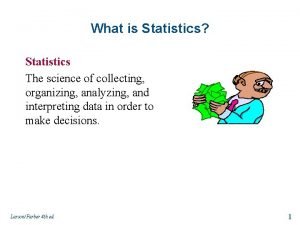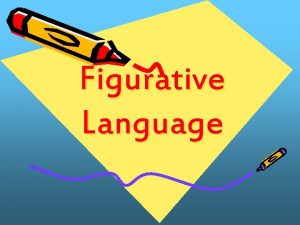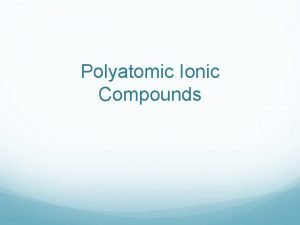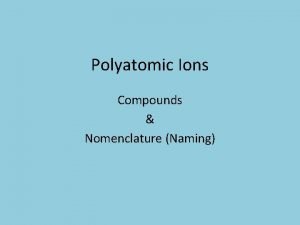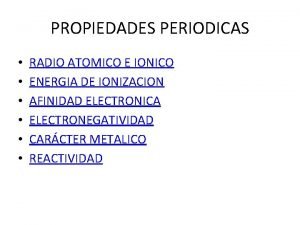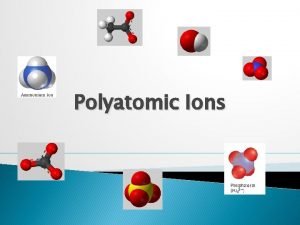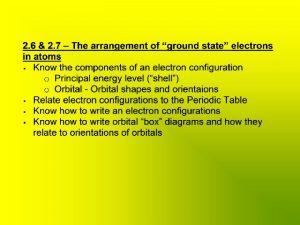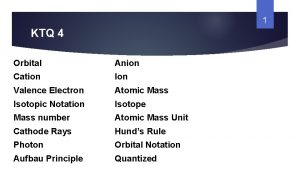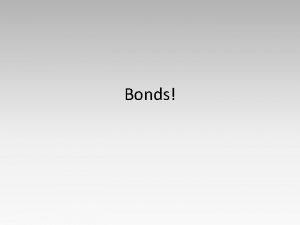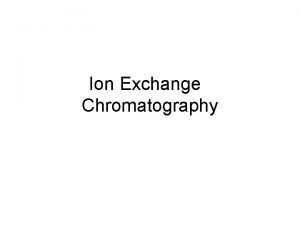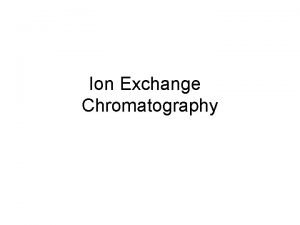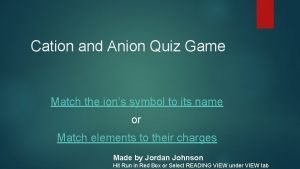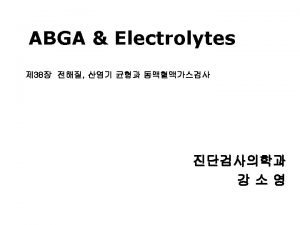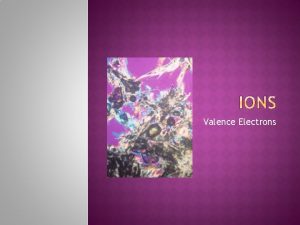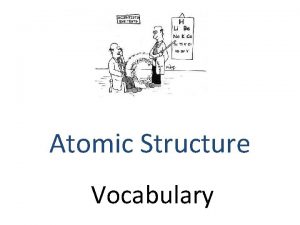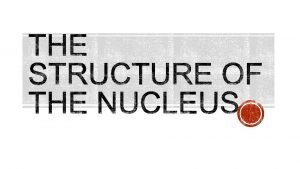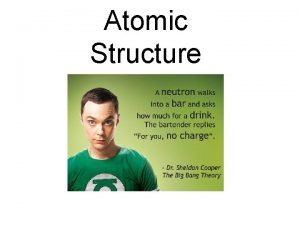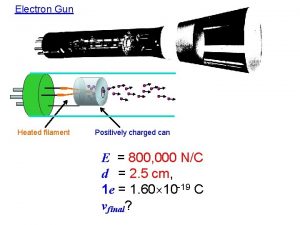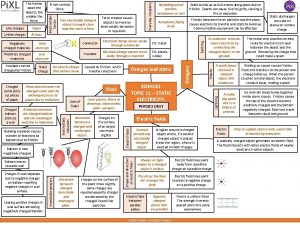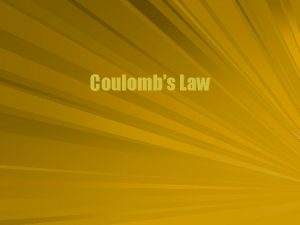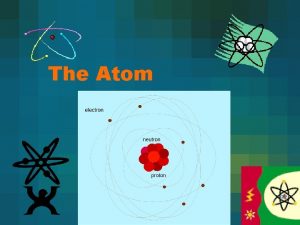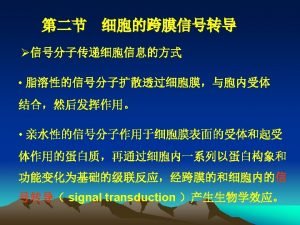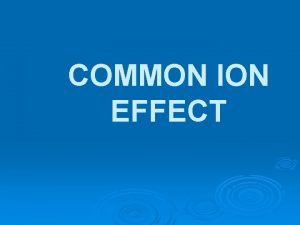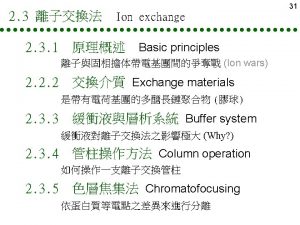Define Cation a positively charged ion Anion a








![Lewis Dots for Ionic compounds 1+ [Li] [ 1 F] 2+ [Ca ] [O Lewis Dots for Ionic compounds 1+ [Li] [ 1 F] 2+ [Ca ] [O](https://slidetodoc.com/presentation_image_h2/bcfd3f29fc14d26c76b44e3dcd5a6743/image-9.jpg)




























- Slides: 37


Define: › Cation – a positively charged ion › Anion – a negatively charged ion › Oxidation number – the charge on an ion › Electronegativity – How strongly an atom attracts other electrons. › Lone Pair - Those two valence electrons in a Lewis Dot structure that are NOT bonded. › Bonding Pair - Two valence electrons shared between atoms that ARE bonded.

An atom that gains one or more electrons will have a NEGATIVE __________ charge. An atom that loses one or more electrons will have a POSITIVE __________ charge. An atom that gains or loses one or more electrons is ION___ called an _____. CATION A positive ion is called a _______ and a negative ion is called an ________. ANION

Ionic Bonds ELECTRONS to another to Atoms will transfer one or more ________ form the bond. COMPLETE Each atom is left with a ________ outer shell… that is (usually) with 8 electrons METAL ion with a positive An ionic bond forms between a ______ NONMETAL charge and a ________ ion with a negative charge.

Because opposites attract! + cation Na - anion Cl

Ionic Bonds Positive cations and the negative anions are attracted to one another… Get a few trillion anions bonded to a few trillion cations and you’ll have a lattice structure, e. g. crystal

Properties of Ionic Compounds Structure: Crystalline solids Melting point: high Boiling Point: high Electrical Excellent Conductivity: Solubility in Usually water:

List of Common Metal & Nonmetal Ions Cations Ion name Li+ Na+ K+ Mg 2+ Ca 2+ Ba 2+ Al 3+ Lithium Sodium Potassium Magnesium Calcium Barium Aluminum Anions Ion Name F- Fluoride Cl- Chloride Br- Bromide I- Iodide O 2 - Oxide S 2 - Sulfide N 3 - Nitride P 3 - Phosphide
![Lewis Dots for Ionic compounds 1 Li 1 F 2 Ca O Lewis Dots for Ionic compounds 1+ [Li] [ 1 F] 2+ [Ca ] [O](https://slidetodoc.com/presentation_image_h2/bcfd3f29fc14d26c76b44e3dcd5a6743/image-9.jpg)
Lewis Dots for Ionic compounds 1+ [Li] [ 1 F] 2+ [Ca ] [O 2+ [Ca ] 2[ F 2] 1]

Examples of Ionic compounds Mg 2+ 2(Cl ) - Magnesium chloride: Magnesium loses two electrons and each chlorine gains one electron 2(Na)+ O 2 - Sodium oxide: Each sodium loses one electron and the oxygen gains two electrons 2( Al )3+3( S )2 - Aluminum sulfide: Each aluminum loses three electrons (six total) and each sulfur gains two electrons (six total)

Covalent Bonds SHARE one or more electrons with each other to form Atoms ______ the bond. COMPLETE Each atom is left with a ________ outer shell. NONMETAL A covalent bond forms between two _________.

Sharing is caring! O O

Covalent Bonds � Electrons are shared between nonmetals & other nonmetals › Can share 1, 2, or 3 electrons › Neither atom is “strong” enough to swipe It… so they share it.

1 line = 2 electrons Covalent Bonds Single Bond! Cl Cl

2 lines = 4 electrons Covalent Bonds Double Bond! O O

3 lines = 6 electrons Covalent Bonds Triple Bond! N N

Step 1: O C O The least electronegative is usually the one with the least valence electrons

Step 2: O C O

Step 3: O C O

Step 4: O C O

Lewis Dots for Covalent Bonds Cl Cl O O

Dihydrogen monoxide H 2 O H

Carbon has lots of ways to share H H C H H

Ammonia H H N H

Your turn… � I 2 � S 2 � P 2 � OF 2 � NF 3 � Si. H 4

Properties of Covalent Compounds Structure: Solid, liquid or gas Melting point: low Boiling Point: low Electrical Not at all Conductivity: Solubility in Not as much as ionic water: compounds

Non-Polar Covalent Bonds � electronegativity difference between 0. 0 - 0. 3 › …usually it’s the same diatomic element bonding to itself. � Or if the middle atom is pulled symmetrically in all direction › Ex. O 2, N 2, CO 2, CH 4

Non-Polar Covalent Bonds Each H is pulling just as strongly on Carbon as all the others are, so this bond is… Non-Polar

Polar Covalent Bonds � electronegativity difference between 0. 4 – 1. 7 � One atom here is tugging harder on the electron than the other one. . . Which one and why?

We can usually tell the type of bond by finding the difference in electronegativity of the two atoms that are bonded.

Electronegativity Differences Difference Bond Type › 1. 7 to 4. 0: Ionic › 0. 3 to 1. 7: Polar Covalent › 0. 0 to 0. 3: Non-Polar Covalent Example: Na. Cl Na = 0. 8 Cl = 3. 0 - 0. 8 = 2. 2

Electronegativity increases this way

Exceptions to the Octet Rule 3 types 1. Molecules with an odd number of electrons; 2. Molecules in which one atom has less than an octet; 3. Molecules in which one atom has more than an octet.

Odd Number of Electrons • Few examples. Generally molecules such as Cl. O 2, NO, and NO 2 have an odd number of electrons.

Less than an Octet • Relatively rare. • Molecules with less than an octet are typical for compounds of Groups 1 A, 2 A, and 3 A. • Most typical example is BF 3. • Formal charges indicate that the Lewis structure with an incomplete octet is more important than the ones with double bonds.

More than an Octet • This is the largest class of exceptions. • Atoms from the 3 rd period onwards can accommodate more than an octet. • Beyond the third period, the d-orbitals are low enough in energy to participate in bonding and accept the extra electron density.

Step 2: C O 6 + 4 O + 6 = 16
 What is a positively charged ion called
What is a positively charged ion called Positively charged atom
Positively charged atom Positively charged atom
Positively charged atom Positive charged amino acids
Positive charged amino acids Positively charged balloon
Positively charged balloon Which of the charges qa, qb, and qc are positively charged?
Which of the charges qa, qb, and qc are positively charged? Which scientist described a positively charged core
Which scientist described a positively charged core Ligação ionica
Ligação ionica Feco3 cation and anion
Feco3 cation and anion Fe(br)3
Fe(br)3 Limiting radius ratio
Limiting radius ratio Mass of kclo3
Mass of kclo3 Carbonic acid cation and anion
Carbonic acid cation and anion Calcium iodide cation and anion
Calcium iodide cation and anion Neon model atom
Neon model atom 12 electrons
12 electrons Ejemplo de fuerza ion ion
Ejemplo de fuerza ion ion Ion dipolo
Ion dipolo Uniones intermoleculares
Uniones intermoleculares Vapor pressure and intermolecular forces
Vapor pressure and intermolecular forces Positively mad mind map
Positively mad mind map How to permanently charge an object using induction
How to permanently charge an object using induction Positively negative poem
Positively negative poem Someone drunk
Someone drunk Autism
Autism Were the mongols positive or negative
Were the mongols positive or negative Find the interquartile range
Find the interquartile range Coursera
Coursera Explain five factors that influence communication
Explain five factors that influence communication Assume risk and return are positively related
Assume risk and return are positively related Figurative versus literal language
Figurative versus literal language Bill busters canada
Bill busters canada Definition of a polyatomic ion
Definition of a polyatomic ion Polyatomic ion
Polyatomic ion Cation exchange capacity
Cation exchange capacity Cation trivalente
Cation trivalente Radio atomico e ionico
Radio atomico e ionico Different ions
Different ions
